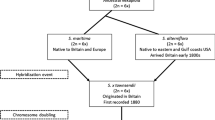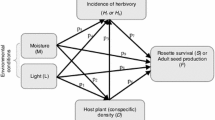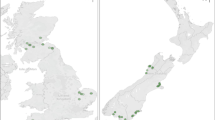Abstract
The biotic resistance hypothesis is a dominant paradigm for why some introduced species fail to become invasive in novel environments. However, predictions of this hypothesis require further empirical field tests. Here, we focus on evaluating two biotic factors known to severely limit plants, interspecific competition and insect herbivory, as mechanisms of biotic resistance. We experimentally evaluated the independent and combined effects of three levels of competition by tallgrass prairie vegetation and two levels of herbivory by native insects on seedling regeneration, size, and subsequent flowering of the Eurasian Cirsium vulgare, a known invasive species elsewhere, and compared its responses to those of the ecologically similar and co-occurring native congener C. altissimum. Seedling emergence of C. vulgare was greater than that of C. altissimum, and that emergence was reduced by the highest level of interspecific competition. Insect leaf herbivory was also greater on C. vulgare than on C. altissimum at all levels of competition. Herbivory on seedlings dramatically decreased the proportion of C. vulgare producing flower heads at all competition levels, but especially at the high competition level. Competition and herbivory interacted to significantly decrease plant survival and biomass, especially for C. vulgare. Thus, both competition and herbivory limited regeneration of both thistles, but their effects on seedling emergence, survival, size and subsequent reproduction were greater for C. vulgare than for C. altissimum. These results help explain the unexpectedly low abundance recorded for C. vulgare in western tallgrass prairie, and also provide strong support for the biotic resistance hypothesis.



Similar content being viewed by others
References
Agrawal AA, Kotanen PM, Mitchell CE, Power AG, Godsoe W, Klironomos J (2005) Enemy release? An experiment with congeneric plant pairs and diverse above- and belowground enemies. Ecology 86:2979–2989
Andersen CP, Louda SM (2008) Abundance of and floral herbivory on exotic bull thistle versus native tall thistle in western tallgrass prairie. In: Proceedings of 20th North American prairie conference 20:33–50
Carpenter D, Cappuccino N (2005) Herbivory, time since introduction and the invasiveness of exotic plants. J Ecol 93:315–321
Carson W, Root R (1999) Top-down effects of insect herbivores during early succession: influence on biomass and plant dominance. Oecologia 121:260–272
Crawley MJ (1989) Insect herbivores and plant population dynamics. Ann Rev Entomol 34:531–564
Daehler C (2003) Performance comparisons of co-occurring native and alien invasive plants: implications for conservation and restoration. Annu Rev Ecol Syst 34:183–211
Eckberg J (2008) Native insect herbivory on invasion dynamics of Cirsium vulgare (bull thistle) (MS thesis). University of Nebraska-Lincoln, Lincoln
Elton CS (1958) The ecology of invasions by animals and plants. Wiley, New York
Erneberg M (1999) Effects of herbivory and competition on an introduced plant in decline. Oecologia 118:203–209
Going B, Hillerislambers J, Levine J (2009) Abiotic and biotic resistance to grass invasion in serpentine annual plant communities. Oecologia 159:839–847
Guretzky J, Louda SM (1997) Evidence for natural biological control: insects decrease survival and growth of a native thistle. Ecol Appl 7:1330–1340
Gustafsson C, Ehrlen J (2003) Effects of intraspecific and interspecific density on the demography of a perennial herb, Sanicula europaea. Oikos 100:317–324
Hämback P, Beckerman A (2003) Herbivory and plant resource competition: a review of two interacting interactions. Oikos 101:26–37
Harper JL (1977) Population biology of plants. Academic, London
Holt RD (1977) Predation, apparent competition, and the structure of prey communities. Theor Popul Biol 12:197–229
Jacobs JS, Sing SE, Martin JM (2006) Influence of herbivory and competition on invasive weed fitness: observed effects of Cyphocleonus achates (Coleoptera: Curculionidae) and grass-seeding treatments on spotted knapweed performance. Environ Entomol 35:1590–1596
Jongejans E, Skarpaas O, Tipping PW, Shea K (2007) Establishment and spread of founding populations of an invasive thistle: the role of competition and seed limitation. Biol Invasions 9:317–325
Julien MH, Griffiths MW (1998) Biological control of weeds: a world catalog of agents and their target weeds, 4th edn. CABI-Bioscience, Wallingford
Kaul RB, Sutherland DM, Rolfsmeier SB (2006) The flora of Nebraska. School of Natural Resources. Institute of Agriculture and Natural Resources, University of Nebraska-Lincoln, Lincoln
Klinkhamer PGL, De Jong TJ, van der Meijden E (1988) Production, dispersal and predation of seeds in the biennial Cirsium vulgare. J Ecol 403–414
Kuijper DPJ, Nijhoff DJ, Bakker JP (2004) Herbivory and competition slow down invasion of a tall grass along a productivity gradient. Oecologia 141:452–459
Lau JA, Strauss SY (2005) Insect herbivores drive important indirect effects of exotic plants on native communities. Ecology 86:2990–2997
Levine JM, Adler PB, Yelenik SG (2004) A meta-analysis of biotic resistance to exotic plant invasions. Ecol Lett 7:975–989
Liu H, Stiling P, Pemberton RW (2007) Does enemy release matter for invasive plants? Evidence from a comparison of insect herbivore damage among invasive, non-invasive and native congeners. Biol Invasions 9:773–781
Louda SM (1982) Reduction in plant recruitment by flower and seed feeding insects. J Ecol 70:43–54
Louda SM, Potvin MA (1995) Effect of inflorescence-feeding insects on the demography and lifetime of a native plant. Ecology 76:229–245
Louda SM, Rand TA (2002) Native thistles: expendable or integral to ecosystem resistance to invasion? In: Kareiva P, Levin SA (eds) The importance of species: perspectives on expendability and triage. Princeton University Press, Princeton, pp 5–15
Louda SM, Rodman JE (1996) Insect herbivory as a major factor in the shade distribution of a native crucifer (Cardamine cordifolia A. Gray, Bittercress). J Ecol 84:229–237
Mack RN (1996) Predicting the identity and fate of plant invaders: emergent and emerging approaches. Biol Conserv 78:107–121
Maron JL, Vilà M (2001) When do herbivores affect plant invasion? Evidence for the natural enemies and biotic resistance hypotheses. Oikos 95:361–373
Meiners SJ, Handel SN (2000) Additive and nonadditive effects of herbivory and competition on tree seedling mortality, growth, and allocation. Am J Bot 87:1821
Rand TA (2003) Herbivore-mediated apparent competition between two salt marsh forbs. Ecology 84:1517–1526
Rose KE, Louda SM, Rees M (2005) Demographic and evolutionary impacts of native and invasive insect herbivores: a case study with Platte thistle, Cirsium canescens. Ecology 86:453–465
Russell FL, Rose KE, Louda SM (2010) Seed availability and insect herbivory limit recruitment and adult density of native tall thistle. Ecology 91:3081–3093
Seastedt TR, Suding KN (2007) Biotic constraints on the invasion of diffuse knapweed (Centaurea diffusa) in North American grasslands. Oecologia 151:626–636
Suding KN, LeJeune KD, Seastedt TR (2004) Competitive impacts and responses of an invasive weed: dependencies on nitrogen and phosphorus availability. Oecologia 141:526–535
Suwa T, Louda SM, Russell FL (2010) No interaction between competition and herbivory in limiting introduced Cirsium vulgare rosette growth and reproduction. Oecologia 162:91–102
Takahashi M (2006) Insect community composition in ecological resistance to invasiveness of bull thistle in eastern Nebraska (MS thesis). University of Nebraska-Lincoln, Lincoln
Tenhumberg B, Louda SM, Eckberg JO, Takahashi M (2008) Monte Carlo analysis of parameter uncertainty in matrix models for the weed Cirsium vulgare. J Appl Ecol 45:438–447
Thébaud C, Finzi AC, Affre L, Debussche M, Escarre J (1996) Assessing why two introduced Conyza differ in their ability to invade Mediterranean old fields. Ecology 77:791–804
Williamson M, Fitter A (1996) The varying success of invaders. Ecology 77:1661–1666
Wolfe LM (2002) Why alien invaders succeed: support for the escape-from-enemy hypothesis. Am Nat 160:705
Acknowledgments
We thank J. A. Lau, T.E.X. Miller, D. Pilson, J. Stubbendieck, M. Takahashi, two anonymous reviewers and the Associate Editor, D. Pyke, for their constructive advice and suggestions. We also thank M. Mellon, N. West, and K. Webbink for field assistance. We greatly appreciate the encouragement and support of B. Seth at the Pioneers Park Nature Center site. Support was provided by a J.E. Weaver Grant from The Nature Conservancy—Nebraska Chapter, a John Davidson Scholarship, and grants from the School of Biological Sciences at University of Nebraska to T. Suwa, as well as NSF-DEB 0532018 and USDA NRI-2005-35320-15379 grants for thistle research to F. L. Russell and S. M. Louda.
Author information
Authors and Affiliations
Corresponding author
Additional information
Communicated by Dave Pyke.
Electronic supplementary material
Below is the link to the electronic supplementary material.
Rights and permissions
About this article
Cite this article
Suwa, T., Louda, S.M. Combined effects of plant competition and insect herbivory hinder invasiveness of an introduced thistle. Oecologia 169, 467–476 (2012). https://doi.org/10.1007/s00442-011-2207-6
Received:
Accepted:
Published:
Issue Date:
DOI: https://doi.org/10.1007/s00442-011-2207-6




